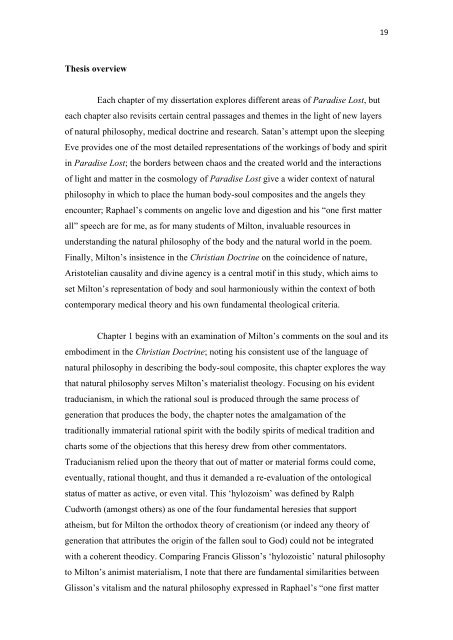Medical Science and the Anatomia Animata in Milton's Paradise Lost
Medical Science and the Anatomia Animata in Milton's Paradise Lost
Medical Science and the Anatomia Animata in Milton's Paradise Lost
You also want an ePaper? Increase the reach of your titles
YUMPU automatically turns print PDFs into web optimized ePapers that Google loves.
Thesis overview<br />
Each chapter of my dissertation explores different areas of <strong>Paradise</strong> <strong>Lost</strong>, but<br />
each chapter also revisits certa<strong>in</strong> central passages <strong>and</strong> <strong>the</strong>mes <strong>in</strong> <strong>the</strong> light of new layers<br />
of natural philosophy, medical doctr<strong>in</strong>e <strong>and</strong> research. Satan’s attempt upon <strong>the</strong> sleep<strong>in</strong>g<br />
Eve provides one of <strong>the</strong> most detailed representations of <strong>the</strong> work<strong>in</strong>gs of body <strong>and</strong> spirit<br />
<strong>in</strong> <strong>Paradise</strong> <strong>Lost</strong>; <strong>the</strong> borders between chaos <strong>and</strong> <strong>the</strong> created world <strong>and</strong> <strong>the</strong> <strong>in</strong>teractions<br />
of light <strong>and</strong> matter <strong>in</strong> <strong>the</strong> cosmology of <strong>Paradise</strong> <strong>Lost</strong> give a wider context of natural<br />
philosophy <strong>in</strong> which to place <strong>the</strong> human body-soul composites <strong>and</strong> <strong>the</strong> angels <strong>the</strong>y<br />
encounter; Raphael’s comments on angelic love <strong>and</strong> digestion <strong>and</strong> his “one first matter<br />
all” speech are for me, as for many students of Milton, <strong>in</strong>valuable resources <strong>in</strong><br />
underst<strong>and</strong><strong>in</strong>g <strong>the</strong> natural philosophy of <strong>the</strong> body <strong>and</strong> <strong>the</strong> natural world <strong>in</strong> <strong>the</strong> poem.<br />
F<strong>in</strong>ally, Milton’s <strong>in</strong>sistence <strong>in</strong> <strong>the</strong> Christian Doctr<strong>in</strong>e on <strong>the</strong> co<strong>in</strong>cidence of nature,<br />
Aristotelian causality <strong>and</strong> div<strong>in</strong>e agency is a central motif <strong>in</strong> this study, which aims to<br />
set Milton’s representation of body <strong>and</strong> soul harmoniously with<strong>in</strong> <strong>the</strong> context of both<br />
contemporary medical <strong>the</strong>ory <strong>and</strong> his own fundamental <strong>the</strong>ological criteria.<br />
Chapter 1 beg<strong>in</strong>s with an exam<strong>in</strong>ation of Milton’s comments on <strong>the</strong> soul <strong>and</strong> its<br />
embodiment <strong>in</strong> <strong>the</strong> Christian Doctr<strong>in</strong>e; not<strong>in</strong>g his consistent use of <strong>the</strong> language of<br />
natural philosophy <strong>in</strong> describ<strong>in</strong>g <strong>the</strong> body-soul composite, this chapter explores <strong>the</strong> way<br />
that natural philosophy serves Milton’s materialist <strong>the</strong>ology. Focus<strong>in</strong>g on his evident<br />
traducianism, <strong>in</strong> which <strong>the</strong> rational soul is produced through <strong>the</strong> same process of<br />
generation that produces <strong>the</strong> body, <strong>the</strong> chapter notes <strong>the</strong> amalgamation of <strong>the</strong><br />
traditionally immaterial rational spirit with <strong>the</strong> bodily spirits of medical tradition <strong>and</strong><br />
charts some of <strong>the</strong> objections that this heresy drew from o<strong>the</strong>r commentators.<br />
Traducianism relied upon <strong>the</strong> <strong>the</strong>ory that out of matter or material forms could come,<br />
eventually, rational thought, <strong>and</strong> thus it dem<strong>and</strong>ed a re-evaluation of <strong>the</strong> ontological<br />
status of matter as active, or even vital. This ‘hylozoism’ was def<strong>in</strong>ed by Ralph<br />
Cudworth (amongst o<strong>the</strong>rs) as one of <strong>the</strong> four fundamental heresies that support<br />
a<strong>the</strong>ism, but for Milton <strong>the</strong> orthodox <strong>the</strong>ory of creationism (or <strong>in</strong>deed any <strong>the</strong>ory of<br />
generation that attributes <strong>the</strong> orig<strong>in</strong> of <strong>the</strong> fallen soul to God) could not be <strong>in</strong>tegrated<br />
with a coherent <strong>the</strong>odicy. Compar<strong>in</strong>g Francis Glisson’s ‘hylozoistic’ natural philosophy<br />
to Milton’s animist materialism, I note that <strong>the</strong>re are fundamental similarities between<br />
Glisson’s vitalism <strong>and</strong> <strong>the</strong> natural philosophy expressed <strong>in</strong> Raphael’s “one first matter<br />
19
















